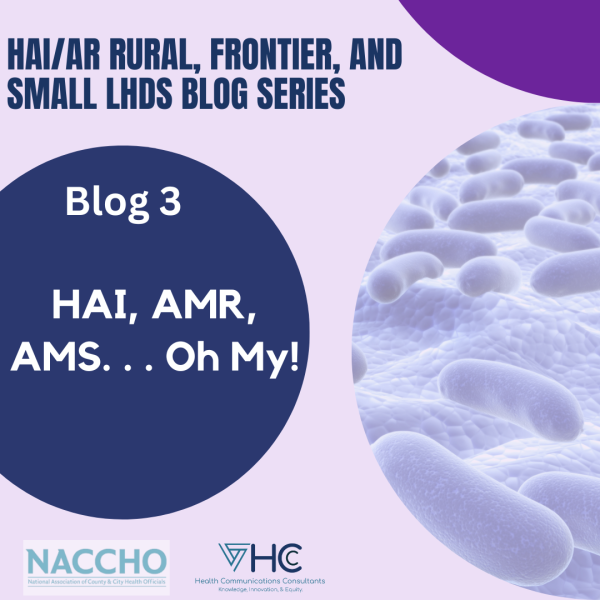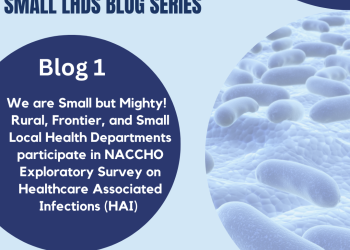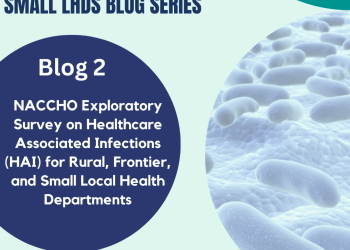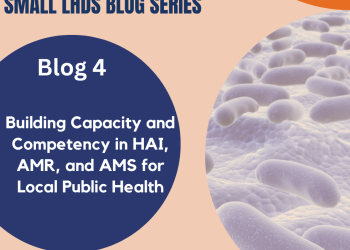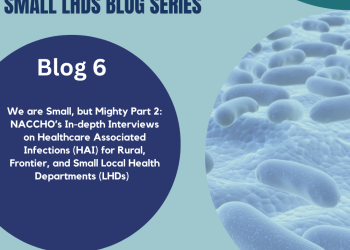Local Rural, Frontier and Small Local Health Departments may ask, “How am I supposed to do this work if I don’t even know what HAI, AMR, or AMS means?”
What is HAI?
A healthcare-associated infection (HAI) is an infection that develops as a result of medical care and develops during, or soon after, receiving healthcare services or being in a healthcare setting. These unanticipated infections can develop during medical or surgical treatment in a hospital, outpatient surgery center, clinic, doctor’s office, nursing home, rehabilitation facility, or while receiving wound care services or other home-care visits by a health professional.1
What is AMR?
Antimicrobial Resistance (AMR) occurs when bacteria, viruses, fungi, and parasites change over time and no longer respond to medicines. This makes AMR infections harder to treat and increases the risk of disease spread, severe illness, and death.2
The World Health Organization (WHO) has declared AMR as one of the top 10 global public health threats facing humanity.2 It has emerged as one of the principal public health problems of the 21st century that threatens the effective prevention and treatment of an ever-increasing range of infections caused by bacteria, parasites, viruses, and fungi no longer susceptible to the common medicines used to treat them. Additionally, the cost of AMR to the economy is significant. Over and above death and disability, prolonged illness results in longer hospital stays, the need for more expensive medicines, and financial challenges for those impacted.
Misuse and overuse of antimicrobials are the main drivers in the development of drug-resistant pathogens. Without effective antimicrobials, the success of modern medicine in treating infections, including during major surgery and cancer chemotherapy, would be at an increased risk. The problem of AMR is especially urgent regarding antibiotic resistance in bacteria. Over several decades, to varying degrees, bacteria causing common or severe infections have developed resistance to each new antibiotic coming to market. Faced with this reality, the need for action to avert a developing global crisis in health care is imperative.3
What is AMS?
Antimicrobial Stewardship (AMS) is a coordinated program that promotes the appropriate use of antimicrobials, improves patient outcomes, reduces microbial resistance, and decreases the spread of infections caused by multidrug-resistant organisms.4 It is a coherent set of actions that promote the responsible use of antimicrobials. This definition can be applied to actions at the individual level as well as the state, national, and global level, and across human health, animal health, and the environment.5 Improving antibiotic prescribing and use is critical to effectively treat infections, protect patients from harms caused by unnecessary antibiotic use, and combat antibiotic resistance.
CDC’s Core Elements of Antibiotic Stewardship offers providers and facilities a set of key principles to guide efforts to improve antibiotic use and, therefore, advance patient safety and improve outcomes. These frameworks complement existing guidelines and standards from key healthcare partner organizations, including the Infectious Diseases Society of America, Society for Healthcare Epidemiology of America, American Society of Health System Pharmacists, Society of Infectious Diseases Pharmacists, and The Joint Commission. The four core elements of outpatient AMS are: 1) commitment, 2) action for policy and practice, 3) tracking and reporting, and 4) education and expertise. For more information, visit https://www.cdc.gov/antibiotic-use/core-elements/outpatient.html.
Why are HAI, AMR and AMS Important?
Infection control is becoming increasingly important for public health worldwide. Center for Disease Control (CDC) estimates that hospital-acquired infections (HAIs) account for an estimated 1.7 million infections and 99,000 associated deaths each year6. WHO reports that at any one time more than 1.4 million people worldwide are estimated to suffer from infections acquired in hospitals7. Because of an increase in invasive procedures and a growing resistance to antibiotics, HAIs have increased by 36% in the last 20 years and are consuming more healthcare resources each year8.
In order to combat the threats posed by HAI, AMR, and AMS, public health must facilitate the creation of prevention strategies, promotion of education, and increased surveillance. Education and training on appropriate antimicrobial prescribing and use, AMR, and AMS principles can provide the foundation of knowledge9 for an effective AMS program10.
CDC provides tools which are designed to help healthcare providers to implement Standard and Transmission-Based Precautions11 to prevent infections. The Targeted Assessment for Prevention (TAP) strategy12 is a framework for quality improvement developed by the Centers for Disease Control and Prevention (CDC) to use data for action to prevent healthcare-associated infections (HAIs). Additional tools can be found at https://www.cdc.gov/hai/prevent/prevention.html.
State HAI and AMR Programs
Thirty-three (33) states require by law that healthcare facilities report HAI data to the National Healthcare Safety Network (NHSN). Links and relevant information can be found at https://www.cdc.gov/HAI/state-based/required-to-report-hai-NHSN.html. State HAI Plans from 2015-2020 are archived on the CDC website at https://www.cdc.gov/hai/state-based/state-hai-plans.html. Check with your state health department for additional resources.
Resources
- Strengthening Partner Networks for HAIs and AMRs – https://www.cdc.gov/hai/state-based/networks/index.html
- Alignment between Activities Related to HAI and AR and Public Health Accreditation – https://www.cdc.gove/hai/state-based/crosswalk/index.html
- 2019 AMR Threats Report – https://www.cdc.gov/drugresistance/biggest-threats.html
- National Infection & Death Estimates for Antimicrobial Resistance – https://www.cdc.gov/drugresistance/national-estimates.html
- Developmental Path of the Infection Preventionist – https://apic.org/prefessional-practice/roadmap/
- Antimicrobial Stewardship Practice Resources – https://apic.org/Professional -Practice/Practice-Resources/Antimicrobial-Stewardship/
References
1. Association for Professionals in Infection Control and Epidemiology. What is an HAI? APIC. Retrieved from https://apic.org/monthly_alert...;
2. World Health Organization. (2022). Antimicrobial Resistance. Retrieved from https://www.who.int/news-room/...;
3. Francesca Prestinaci, P. P. (2015). Antimicrobial resistance: a global multifaceted phenomenon. Pathogens and Global Health, 109(7): 309–318. Retrieved from https://www.ncbi.nlm.nih.gov/p...;
4. Future Learn. (n.d.). What is AMS and why is it important? Retrieved from https://www.futurelearn.com/in...;
5. World Health Organization. (2019). Antimicrobial Stewardship Programmes in Health- care Facilities in Low- and Middle-Income Countries: A WHO Practical Toolkit. Retrieved from https://apps.who.int/iris/bits...;
6. Centers for Disease Control and Prevention. (2016). Standard Precautions for All Patient Care. Retrieved from https://www.cdc.gov/infectionc...;
7. World Health Organization. (2009). WHO Guidelines on Hand Hygiene in Health Care: First Global Patient Safety Challenge Clean Care Is Safer Care. Retrieved from https://www.ncbi.nhm.nih.gov/b...;
8. World Health Organization. (2011). The potential for transmission of hospital-acquired infections by non-critical medical devices: the role of thermometers and blood pressure cuffs. Retrieved from https://pubmed.ncbi.nhm.nih.go...;
9. National Library of Medicine. (2020). Tackling Antimicrobial Resistance by promoting Antimicrobial stewardship in Medical and Allied Health Professional Curricula. Retrieved from https://pubmed.ncbi.nhm.nih.go...;
10. National Library of Medicine. (2007). Infectious Diseases Society of America and the Society for Healthcare Epidemiology of America guidelines for developing an institutional program to enhance antimicrobial stewardship. Retrieved from https://pubmed.ncbi.nhm.nih.go...;
11. Centers for Disease Control and Prevention. (2019). Tools for Healthcare Settings. Retrieved from https://www.cdc.gov/infectionc...;
12. Centers for Disease Control and Prevention. (2022). The Targeted Assessment for Prevention (TAP) Strategy. Retrieved from https://www.cdc.gov/hai/precen...;
